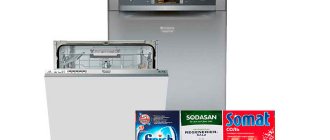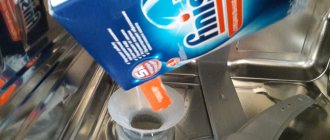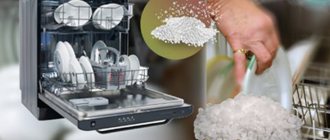Using a dishwasher is an opportunity to free up time and relieve yourself of the work that equipment can do. However, illiterate operation can turn useful equipment into an endless headache. Moreover, most violations are associated with improper loading of dishes into the unit’s tank.
We will tell you how to properly load dishes into the dishwasher. We'll show you the order in which kitchen utensils should be placed for an ideal sanitization result. This article provides advice on choosing tools for operating and maintaining equipment.
Causes of damage to dishes in the car
There are quite a few limitations that limit the possibilities of using a dishwasher, and inept handling of equipment and improper loading lead to unexpected results. The conditions created in the dishwasher limit the ability to wash certain types of dishes in it.
Factors that narrow the functionality of technology:
- very hot water;
- temperature changes;
- hot air drying;
- aggressive chemicals;
- prolonged contact with water, steam.
Temperature shock can cause even tempered glassware that can withstand hot temperatures to crack.
Some dishwasher models take this factor into account - a built-in heat exchanger eliminates sudden temperature changes.
To make the most of the equipment’s potential, purchase dishes with a manufacturer’s mark that they can be washed in a dishwasher. But even following all the rules can lead to damage to tableware.
Restrictions on the type of materials
The dishwasher should not be loaded with cutlery or items made from materials such as:
- Wood. Antique cutlery, spoons, plates, spatulas and cutting boards can become completely damaged due to contact with hot water. The wood will swell and, as it dries, begin to crack and change its shape.
- Plastic. The restriction applies to items made of plastic that cannot withstand high temperatures.
- Copper, tin, silver. Contact with chemicals can cause them to fade, change color, or oxidize.
- Aluminum. Frying pans, pots, meat grinder parts and other aluminum products darken and a coating forms on their surface. Prolonged contact with water is also undesirable.
It is also undesirable to wash cast iron cookware in a machine, since strong detergents help remove the protective layer from them and cause rust.
In a dishwasher, operating modes can last from 30 to 150 minutes. It is clear that wooden dishes, having spent so much time in a humid environment, will absorb a large amount of water and, when dry, can behave differently - swell, crack
A complete list of items allowed and prohibited for loading into the dishwasher is given here; we recommend that you familiarize yourself with the very useful information.
How much does it fit?
How many pots, plates and spoons can you wash at once? Read the instructions to see the capacity. Unit of measurement sets. In small-sized PMMs, 6 sets are washed per cycle, in narrow ones no more than 11, in full-size ones no more than 17.
A set is a set of dishes needed by one person. The manufacturer knows what is included in the kit. Approximate contents: a couple of plates, cutlery, a cup. In fact, the machine fits about 12-14 sets. If you need to wash an additional couple of pots and pans, then less.
Dishes that are not dishwasher safe
Manufacturers do not recommend loading the following dishes into the machine:
- Knives, shredder knives. When heated, they become dull, so it is not advisable to wash them at high temperatures.
- Frying pans and saucepans with Teflon coating. The protective layer of the frying pan is washed off under the influence of detergents, and it loses its non-stick properties.
- Dishes with a vacuum lid and seal. Under the influence of hot water, the seal will be broken and the seal will deteriorate.
- Items with decorative painting. The paint used to decorate the dishes may wash off.
- Objects stained with ash, grease, paint, wax. Anything that can stain equipment and lead to clogging.
In addition to general rules, there are also restrictions for specific dishes - after all, porcelain and plastic can have different compositions and react differently to the harsh conditions of machine washing. Therefore, when purchasing and before loading them into the dishwasher, check their labeling.
Knives tend to become dull in a hot environment. Therefore, it is better to wash them by hand, preferably at a low temperature. You need to be especially careful when handling professional knives.
Likewise, rusty appliances should not be placed in the dishwasher. They will not only be subject to even greater destruction, but will also lead to the formation of rust on metal cutlery that has not yet been touched by corrosion.
Isothermal dishes after being in a dishwashing machine may no longer retain heat due to the destruction of the vacuum seal
Arrangement of cutlery
Knives, forks and spoons of all types and sizes, collectively referred to as cutlery, are placed in a separate basket. Arrange them freely, trying not to place identical devices next to each other. If packed tightly, spoons and forks will not wash off. The position of the knives is strictly downward with the blade.
New PMM models from the Bosch and Siemens brands are equipped with a special tray for spoons and forks. It is located upstairs. The devices are placed in a horizontal position; this is economical, safe and ensures high-quality washing.
Rules for using equipment
Broken or unwashed dishes with food residues, a clogged drain, corrosion inside the device body - all these are consequences of improper operation of the equipment. To avoid having to correct errors, it is better to study the download rules before you start using it.
General location rules
Before loading dishes into the dishwasher bin, remove any remaining food from it - just remove it with a spoon.
Pre-washing kitchen utensils is not only not necessary, but also not recommended, since in this case the sensor technology selects a weak cleaning program mode and stubborn dirt is not washed off.
If possible, cutlery is placed at some distance from each other to provide better access to water jets
There are rules that clearly stipulate how to load dishes and cutlery into the hopper of dishwashing equipment:
- All items must be stable. The plates are placed in special racks; for tall glasses, it is also necessary to provide support (a small shelf located above the upper basket and holders are often adapted for this).
- Dirtier kitchen utensils are placed in the lower rack of the dishwasher. There the water flow is stronger and the washing is more thorough. In addition, dirty water will not flow onto cleaner appliances.
- All containers are placed upside down to prevent water from accumulating in them. Concave and convex objects are placed at an angle, so the water will drain better.
- Tall and narrow containers should not be installed in corners or in an excessively inclined position.
- Nothing should block the rotation of the rocker arms that spray water.
Do not overload the dish baskets or place any items in the detergent tablet compartment.
It is incorrect to place long cutlery, such as spatulas, skimmers, scoops, vertically, especially when the machine is half loaded
Devices for placing dishes
The design of the dishwasher includes the following devices for stable and safe placement of dishes:
- Folding pins - designed for securely holding bowls, glasses, and pans.
- Knife rack - suitable for storing all long items (stacked horizontally).
- Small Item Holders - Securely holds lightweight items such as lids, plastic cups, etc.
- Upper basket (box) - for loading cups, glasses, small plates. Can be placed at different heights.
- Lower basket (box) - designed for large dishes, pots, pans, as well as for heavily soiled appliances.
In addition to the basic accessories, you can additionally purchase a cassette for washing silver, a bottle holder, an attachment for washing baking sheets, a bracket for tall glasses, a box for glasses and wine glasses, etc.
Before starting the washing program, all items must be securely fastened. For this, manufacturers provide many devices - shelves, pins, clamps
Loading rules for each type of cookware
The internal structure of the machine, the location and design of the boxes and shelves in it, are thought out in such a way as to provide the user with convenience and the safety of the dishes.
It is imperative to find support for the legs of tall glasses, otherwise they may break during washing. For this purpose, recesses are most often provided on the edge of the upper folding shelf for knives
To ensure that cutlery is placed stably, washed thoroughly, and does not interfere with the effective functioning of the equipment itself, each type of utensil has its own place:
- Knives, skewers. Place on a special shelf in a horizontal position or in a basket for cutlery (spoons, forks) with the tips down.
- Spoons, spatulas. There is a special basket for them; they are placed vertically.
- Cook's spoons, skimmers. As well as other long cutlery. They are placed on folding shelves that can be installed at different heights and folded up when not needed.
- Cups, glasses. Load into the upper basket upside down, in an inclined but stable position.
- Plates, bowls. They are placed in special sections, one at a time if possible.
- Pots, pans. Place in the lower basket with the bottom up.
Small cutlery is placed on shelves or in baskets with a fine mesh. If they are so small that they fall out of the basket, it is better to wash them by hand.
If water collects in the recesses of the cutlery, it means that the dishes were not positioned correctly - they must be placed not just upside down, but at an angle
The following video will introduce you to the subtleties and specifics of proper arrangement of cutlery when loading into the PMM:
Removing dishes after finishing washing
It is necessary to remove the dishes from the machine after it has cooled to a comfortable temperature, so as not to get burned. In addition, hot glass and porcelain dishes are sensitive to shock and may crack or break when unloaded. To prevent drops from dishes placed in the upper box from flowing onto the appliances located below, they must be unloaded starting from the bottom.
Preparing to download
Before placing plates on the shelves and compartments of the PMM, clear them of food debris. The better you do this, the higher the likelihood of avoiding filter and drain blockages.
On a note! To remove food debris from plates, use paper towels or napkins, a damp sponge, or a rubber spatula, whichever is more convenient. Make sure that there are no eggshells, fruit seeds, or grains left - these are enemies of the drainage system and provocateurs of blockages.
Don't know whether to rinse plates before loading them into the PMM? After rinsing, the quality of washing improves. But equipment owners justifiably wonder why they need a machine if they need to wash it by hand. Therefore, there are models with the “Soak” or “Pre-wash” function. If this option is not available, you will have to soak the plates.
Dishwashing detergents and water softeners
Failure to comply with the norms for loading preparations into the dishwasher, incorrect settings of systems that dose products, or any deviations from the established rules lead to disruption of the dishwashing process. As a result, at the end of the programs, you can observe residues on the dishes and poor washing quality.
For washing use: detergent, salt, rinse aid. The rules for their use are described in detail by each dishwasher manufacturer.
Water softening salt
To thoroughly clean the dishes and avoid the appearance of a layer of scale, it is necessary to soften the water. This is especially true when using water with a high degree of hardness. Regenerating salt is loaded into the container of the water softener. The amount of loading is adjusted depending on the hardness indicators.
You can determine exactly how much softener you need to use based on data on the hardness of tap water in a particular region. The amount of salt for different levels of hardness is indicated in the standard table.
It is better to load salt into the machine before starting the washing program and, once dissolved, it is immediately washed off. If you fill it up earlier, the solution can get on the metal and trigger the start of the corrosion process.
Rinse aid for dishes care
The product is used to prevent water droplets from leaving stains on the dishes. Dish rinse aid is loaded into the container.
When the dishwasher light turns on, it indicates that there is 1-2 loads of rinse aid left. The portion size that is supplied to the system can be adjusted by setting it to a level from 1 to 4.
The required amount of rinse aid can be determined by the condition of the dishes after washing: if streaks remain, the portion can be reduced; if water stains are visible, the portion can be increased
Suitable detergents
Detergents contain slightly alkaline substances containing enzymes that dissolve proteins and break down starch. Some of them contain oxygen bleaches and work well on tea and ketchup stains.
Can be produced in the form of liquid, powder or tablets. The first two options allow the dishwasher to automatically dispense the required amount of product. Our recommended article will help you figure out which is better: powder or tablets.
The tablet is used completely, but sometimes, in order to save money, it is divided in half. The rules for using products from different manufacturers may differ, so before use, study the information on the packaging.
If the dishes are not very dirty, there are no dried traces of food on them, you can use less detergent than indicated in the instructions
You can use combined products that contain detergents, softening salt, and rinse aid if the hardness of your tap water is not higher than 21° dH. When using 3 in 1 products, the rinse aid and salt absence indicators are turned off - most machines support this function.
There are also 4 in 1 and 5 in 1 products, which include additional components to shine stainless steel or protect glass.
Detergents
Finally, I will dwell on some recommendations that are not directly related to loading, but are extremely important for the efficient operation of the machine:
- Do not add too much detergent to the machine. This will cause excessive foam to form and washing will automatically stop.
- Some machines have two detergent reservoirs. First you need to fill out the one on the door. A second container is only needed if there is some dirt left after the first wash.
- First fill the tank located on the door. It should open after the dishwasher has finished pre-rinsing to loosen dirt.
- The machine only uses detergent, rinse aid and salt. Each dishwasher manufacturer describes in detail how and in what doses to use them.
Check before starting
After distributing the dishes, make sure that there is enough space for the top sprinkler to twist - there should be at least 3-5 centimeters to the highest item.
Also, nothing should prevent the dispenser lid from opening and tablets or detergent powder falling out of it - do not place any high objects in the lower tier near the door.
Rules for safe use of the device
Operating a dishwasher requires following safety precautions in the same way as any other equipment:
- Only specialized compounds intended for dishwashers are used as cleaning components. This is especially true for those containing chlorine.
- The door must be closed while the device is operating. It is necessary to check whether the dishes placed inside do not interfere with this. An infrared indicator signals that the door is not tightly closed.
- You must open the door carefully while the program is running to avoid being scalded by water that may splash out of the machine.
- The machine door should only be open when unloading or loading the dishwasher, otherwise you may trip over it while moving around the kitchen.
- Do not put heavy loads on the door, do not sit down or stand on it.
- When installing a dishwasher, including a built-in one, you must strictly follow the installation rules developed by the manufacturer.
You need to be especially careful when using equipment if there are children in the house, and purchase those device models that have child protection programs and lock the car doors, preventing unauthorized access.
Children should not use the dishwasher independently. Young family members should also be prevented from accessing detergents - they contain chemical components.
Mode selection
It is important not only to properly prepare household appliances for use and place the dishes correctly, but also to choose the optimal washing mode. Let's look at how to choose the right washing mode using the example of Bosch equipment, which has 4 modes:
- 70°C – for large containers or overly dirty dishes and utensils;
- 50°C – for dishes with medium soiling;
- 45°C – for washing glass or lightly soiled items;
- rinsing - recommended for use when food has dried on the dishes.
When washing fragile items, select the “Delicate wash” mode. Please note that the Quick Wash mode saves water, electricity and time.
Equipment maintenance and cleanliness
Like any equipment, a dishwasher requires proper handling. After a certain period of operation of the device, you can observe the accumulation of fat, scale, and a humid environment leads to the appearance of fungi.
If deposits of plaque and grease have formed, it is necessary to load detergent into the appropriate chamber and run the program with the highest water heating temperature
Clean the filters from standard contaminants for dishes and rinse them under running water after each dishwashing. Spray arms are less often cleaned of scale and dirt. Each dishwasher manufacturer provides information in its instructions on how to properly remove and clean the removable elements.
Regular cleaning of the dishwasher and compliance with operating rules will significantly extend the service life of the equipment and eliminate the need for repairs and replacement of expensive components.
Special attention should be paid to the seal on the machine door - wipe with a damp cloth lightly moistened with detergent. Also keep the front panel with the controls clean without using a sponge with an abrasive surface.
From time to time it is necessary to carry out automatic washing of equipment using means for sanitizing the hopper and hard-to-reach areas of the unit. If the device is not used for a long time, to avoid the formation of fungus and unpleasant odors, keep its door ajar.
All dishwasher manufacturers provide detailed operating instructions with their products. For the sake of normal operation of the equipment, it is necessary and imperative to adhere to the rules indicated in the manual.
When to pick up after finishing washing
When choosing a PMM operating mode, you need to immediately determine what is the priority - saving time or energy. When operating in normal mode, washing dishes takes an average of 1.5-2 hours. A full cycle consists of rinsing (up to 10 minutes), main wash (up to 50 minutes), rinsing in several stages (up to 10 minutes), drying (from 30 minutes).
It is recommended to wash the dirtiest dishes in intensive mode for about 3 hours. Operating time can be reduced by increasing water temperature and pressure. It should be noted that this mode reduces time and water consumption, but increases energy costs. During this time, preliminary rinsing, washing, subsequent rinsing in 2 passes, and drying will be carried out.
For pans and pots, it is recommended to use the soak mode. The latest models have developed a washing method in which soaking and intensive washing are carried out simultaneously. These processes take place in 2 different baskets. At the same time, water consumption is reduced by approximately 25% while maintaining the quality of dishwashing.
Conclusions and useful video on the topic
The science behind loading your dishwasher:
Surely, you have not washed these items in the dishwasher yet and you will be interested in watching the video:
Most of the problems and malfunctions that arise during the operation of a dishwasher are a consequence of its improper use. Proper treatment and care of equipment will help not only preserve the appearance of kitchen utensils, but also extend the life of the device itself.
Would you like to talk about how you load dishes into your “home assistant”? Would you like to share the secrets of rational use of space in a bunker? Please write comments in the block below, post photos related to the topic of the article, and ask questions.











